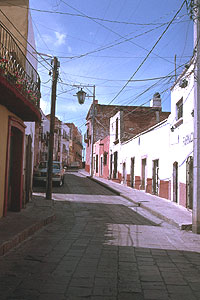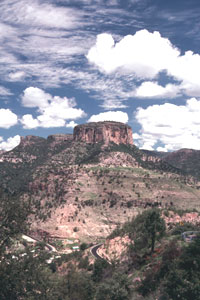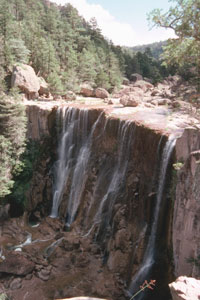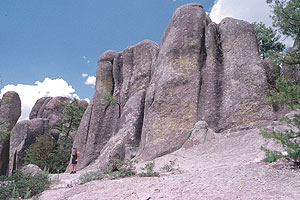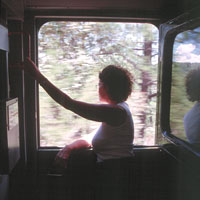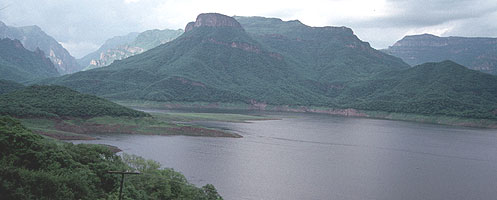Friday, 16 August 2002
Mexico, Mexico
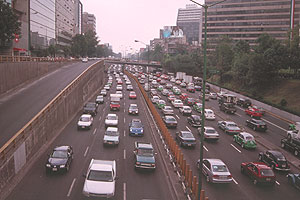
(Mexico, Mexico)
We touched down in Mexico late on Friday Night. Due to undocumented changes in the Mexican phone system we had not been able to ring ahead and arrange a hotel so we had to ring from the airport. We then got a taxi into the "Zona Rosa" Mexico's supposed tourist centre. I say "Mexico" because it is important to understand that it is only outside Mexico that the capital is referred to as "Mexico City". This does not confuse the locals because when they want to refer to their country they simply say "La Republica". So for that added touch of authenticity I will stick with calling the capital "Mexico".
The hotel we were staying in was very nice. An old converted villa, it still had many original features and some original furniture. As it was getting late we dropped our bags off and dashed out to have a look around. Outside we found that Friday night in the Zona Rosa was lively. Restaurants and bars lined small streets named after various major cities such as "Hamburgo" and "Londres". Each restaurant seemed to retain an in house band and each band had cranked their amps up to eleven in an attempt to get themselves heard over the neighboring bands. The result was a none too harmonious blend of every conceivable genre of music, which gave the streets a carnival like atmosphere.
We opted for a bar amusingly called "Yuppie's Sports Cafe" where one of the speakers had failed and the choice of music, 80's rock ballads, was at least bearable. We had a couple of beers, got ripped off with a suggested tip which our jet lag ridden brains were not able to spot as being 30% and then went back to the hotel to bed.
Saturday, 17 August 2002
Zacatecas, Mexico
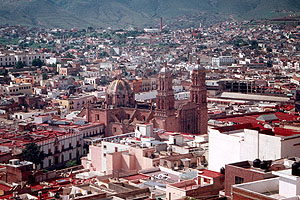
(Zacatecas, Mexico)
As usual for us we had chosen a pretty harsh itinerary. Our aim was to get to a place called Creel some 1500 km away from Mexico up in the mountains just south of the US border. Quite why when planning a holiday we always look in the guide book and set our hearts on the most difficult to reach location I will never know. It may be something to do with the fact that the places near the capital cities always lack an air of mystery. If we were tourists visiting the UK I am sure we would find places like Oxford and Bath too pedestrian and kill ourselves trying to get to the Lake District or the Outer Hebrides.
This time we had a plausible excuse, it was the rainy season. The Yucatan, to the South of Mexico, has most of the well known tourist destinations however these are mostly in low lying areas and unbearably humid. Although it also has cooler villages in the mountains the rain has a tendency to wash out roads making travelling hard. Therefore having just endured two weeks of in the UK, the North with its deserts and more Californian like climate seemed the place to be.
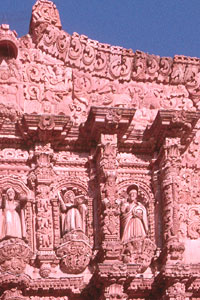
(Zacatecas, Mexico)
First stop was Zacatecas, an old silver mining town founded in 1546 by Spaniards eager to exploit the mineral wealth of "New Spain". Although on the map it seems just a stone's throw away from Mexico it is in fact an eight hour bus journey. The first hour or so was spent simply getting out of Mexico, which with a population of 23 million is the world's largest city. After this the buildings gave way to endless flat fields which in turn gave way to uncultivated mountain sides covered in agarve and prickly pear cacti.
For some reason best known to the driver we did not stop for lunch until three at some fly infested roadside cafe seemingly owned by Omnibus de Mexico, the company we were travelling with. It was at this point that the rain decided to pour down. It lasted for an hour and it was torrential confirming for us that North was the direction to head in.
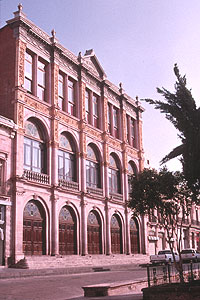
(Zacatecas, Mexico)
We finally got to Zacatecas at 5pm and at first were a little bit worried about what we had let ourselves in for. However once we had got in to the older town centre we began to warm to the place. Situated 2400m up in mountains the town was built in the shadow of a rather familiar "Cerro Rico", or rich hill, which is honeycombed with mine shafts. Once we had negotiated a rather scruffy hotel room we set out for a wander. At the heart of the old town is a rather impressive red sandstone cathedral constructed in the 1750's. In addition to the cathedral a lot of the building surrounding it were built with the same red stone which in the light of the late afternoon gave the town a warming glowing feel. Unlike Potosi in Bolivia, which it reminded us a bit of, the Spaniards did not manage to exhaust all of the silver and mining continued into the twentieth century with a lot of the buildings, like the theatre dating from the late nineteenth century. The town was also full of lots of small squares and gardens and we realised that were it not for our aggressive schedule Zacatecas would be an ideal place to wile away two or three days.
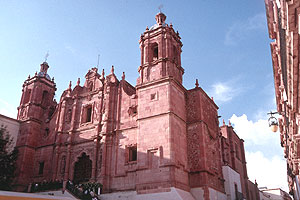
(Zacatecas, Mexico)
Having done our exploration our top priority was to get our first taste of Mexican food. We found a recommended restaurant and had an okay-ish dinner. My taco starter was very nice however I decided to follow this up with Quesadilla con Pollo and discovered that the pollo in question was a large hunk of one of those spit roasted chickens that twirl around endlessly in front of slow cooking grills in the majority of the world outside of Europe.
Anyway the food was more than made up for by my first chance to order some "Negra Modelo", a dark Mexican beer and one of my favorites back in England. After dinner instead of sampling the attractions of Zacatecas' nightclub down a mine shaft or watching a rather bizarre singing act on the stage which had been set up in one of the smaller squares as part of the week long "La Morisma" festival, we decided to crash out. Probably as a result of jet lag.
Sunday, 18 August 2002
Zacatecas, Mexico
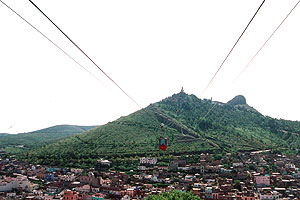
(Zacatecas, Mexico)
Having found that Zacatecas was a pretty pleasant place to hang out we were determined not to spend the whole day travelling and were aiming for an overnight bus to Chihuahua, our next destination. Thus we had most of the day to explore. First up was breakfast which I was very much looking forward to as the Mexicans are very much into scrambled eggs. We found a place which served fifteen different varieties: "Huevos Rancheros" - scrambled eggs with a barbecue like sauce and "Huevos Mexicana" - scrambled eggs with green pepper and tomato (the colours of the mexican flag) being two examples. However when our order arrived we found the eggs a little overcooked.
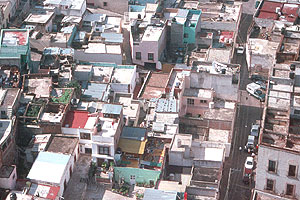
(Zacatecas, Mexico)
Following breakfast we took a trip up to the top of "La Bufa" one of the hills surrounding the village which can be accessed by a dramatic cable car ride up from the town centre. The top of the hill was a little bit of a tourist trap with a small church and a set of monuments but nevertheless it had a good view.
We came down the hill via a stone path and emerged into the back streets of Zacatecas. This was a very interesting little diversion as although the town centre was very clean and well built in comparison the back streets had their own special charm. The houses were completely randomly built, painted in vivid colours and most of them had balconies which overflowed with flowers and washing lines.
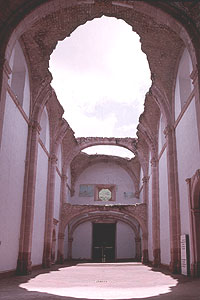
(Zacatecas, Mexico)
After navigating our way slowly back to the hotel we packed our bags, put them in storage and headed for the Museo Raphael Coronel. The Coronel brothers were both wealthy painters who built up massive collections of artifacts and bequeathed them to the town. Raphaels collection consisted mainly of masks, some two thousand of them used in the various dances and rituals that take place all over the country. However it was not the masks but the building that they were housed in that proved to be the star. The partially restored 16th Century San Fransiscan convent. It was a lovely mixture of ruin, gardens and restored galleries.
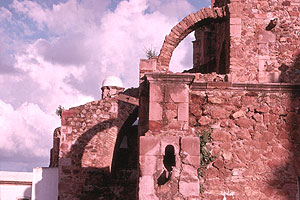
(Zacatecas, Mexico)
We did have the intention to follow this up with a trip into Zacatecas' mines. However we decided to give it a miss as we felt that we would draw unfair comparisons with Bolivia's Potosi, which had been such a shocking experience that nothing could compare. Well that and it was also too nice a day to spend down a mine shaft. Instead we went for lunch in a great little local institution the "Taqueria La Unica Cabana". Here they sold an amazing range of Tacos, not the hard shell tacos we get in the UK but small soft tortillas filled with your choice of filling. The options included chorizo, minced beef, tongue and the somewhat mysteriously named "Cebola" or "head" which appeared to be a mixture of brains and other assorted offal.
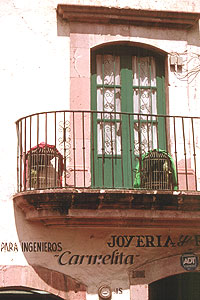
(Zacatecas, Mexico)
After this we headed for the bus station. In retrospect we made a bit of a mistake going at four in the afternoon however it did allow us to see a bit of the country. We had the usual afternoon rain which was followed up by an amazing lightning storm. I was able to get some sleep however we had completely overestimated the time it would take and we rolled into Chihuahua on time a 3am. Worse still it is in a different time zone so it was actually 2am and the first bus to Creel was not until 6am !! Rather than spend four hours asleep in a bus station, as we would have done in our earlier trips, we decided to get some sleep and check in to a rather dubious motel next to the bus station.
Monday, 19 August 2002
Creel, Chihuahua, Mexico
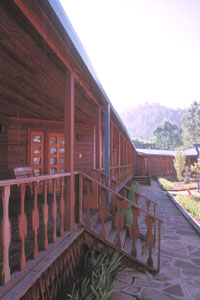
(Creel, Chihuahua, Mexico)
Needless to say with our two o'clock finish and no alarm clock we did not make the six o'clock bus. We got to the ticket office at ten to eight and as luck would have it there was a bus at eight. We hopped aboard and the bus set off into the mountains. Although the scenery was dramatic in a couple of places on the whole it consisted of prarie like plains and huge orchards. According to our guide book this area is inhabited by Mennonites a sect of Amish like puritans who were persecuted because of their beliefs and refusal to do military service and fled their native Germany first to Russia then Canada and then Mexico. A little before Creel the valley narrowed and we could at last be said to be in a canyon.
Creel, the gateway to the "Barranca Cobre" or "Copper Canyon", was not at all how we had imagined it. I had an image of a few log cabins nestling in a narrow mountain valley. In truth however it was a large, tatty sort of place spread out in a plain between rolling hills. When we first arrived we were completely horror struck. However once we got to the "Best Western Lodge at Creel" to find that it was low season so rooms were half price and settled into our five star log cabin, complete with wood burning stove and rocking chair, things began to look up.
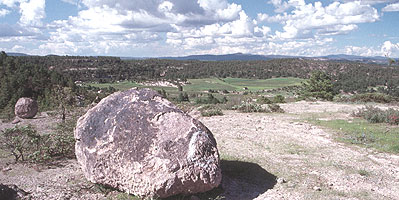
(Creel, Chihuahua, Mexico)
The only problem with using Creel as a base to explore the "Barranca Cobre" is that it is nowhere near it. Because of this you have to hire jeeps and to do this you need other tourists. So once we had settled in we went out to scout for other tourists. Pretty soon however we started to realise exactly how low season it really was. There was nobody around !! We tried the tourist office but it had shut down. We looked for the local travellers haunt but it had shut down for renovations. Pretty soon we were in a bit of a panic. After a while we gave up and went for a walk up in the cliffs behind the town. There were plenty of paths and we managed to get up to the top of the tallest hill around on top of which was a scattering of monolithic rocks.
When we finally got back to the hotel we had a stroke of luck, proving that a watched pot never boils. The hotel was organising a tour the next day to a local waterfall followed by a couple of the main canyons for the only other guests, we immediately signed up. That night we ate in the Hotel's "Sierra Madre Pub" having balked at eating in the completely empty restaurant because it looked like an exact replica of the restaurant of the lodge in Kubrick's "The Shining".
Tuesday, 20 August 2002
Creel, Chihuahua, Mexico
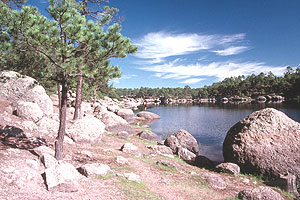
(Creel, Chihuahua, Mexico)
We woke up early, too early in fact as our tour was not scheduled to start until nine, We sat outside the lodge waiting for the other couple to tun up. When they finally did it was a couple of middle aged Mexicans. We piled into a minibus, not a Jeep to our distress, and set off down the road.
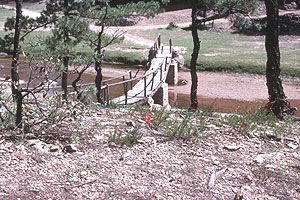
(Creel, Chihuahua, Mexico)
The first stop was Lago Areko, a small artificial lake just down the road from Creel. It was very picturesque being surrounded by grey monoliths and having perfectly still water. After staring at it for a while we headed off to Cusarare Waterfall. This was a bit more adventurous, a 3km walk down a very scenic path along a river canyon, with the occasional rickety wooden bridge or maize field. The only people we met were Tarahumara Indians selling baskets woven out of the foot long needles of the Apache Pine.
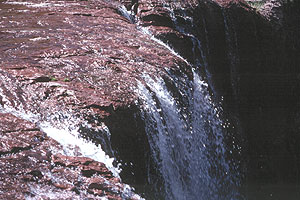
(Creel, Chihuahua, Mexico)
Cusarare waterfall was amazing. We came to it from upstream and just as the river had started to spread out over a large flat area of rock the rock suddenly fell away and we found ourselves standing on the lip of a 30m drop. The whole area was surrounded by pine trees and the sun was shining so it called for the taking of a lot of photographs before we finally headed back to the tour bus.
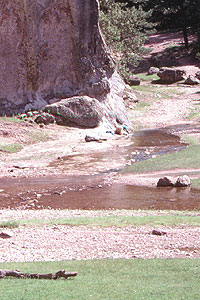
(Creel, Chihuahua, Mexico)
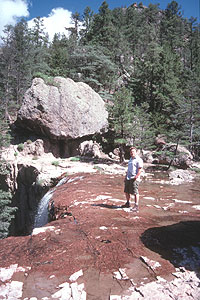
(Creel, Chihuahua, Mexico)
After that the tour consisted of a drive through the canyons along a road which weaved up and down from canyon to canyon. The landscape changed from dense pine forest to a drier more mountainous terrain full of exposed mesas and buttes. The surroundings were dramatic however being cooped up in a minibus was no way to appreciate it. The final point of the tour was a bridge over the river Urique where we had lunch.
We got back to the hotel at ten to three despite us having been told that it would last much longer. We suspect that this was to return it in time for a late afternoon tour to Lago Areko which left immediately after we got back. We then decided to hang around the hotel planning the next day's walking, no way were we going to be driven around again despite our guide's numerous tour suggestions. We popped into the local supermarket, bought some Sol beers, sat in the sun on the porch of our log cabin and planned the days ahead in Mexico. That night we had the full "The Shining" experience, some more people had checked in making the dining room feel a safer place to eat.
Wednesday, 21 August 2002
Creel, Chihuahua, Mexico
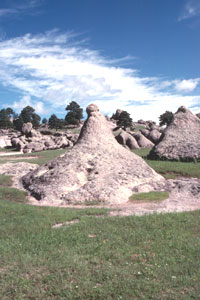
(Creel, Chihuahua, Mexico)
We had no intention of spending one minute of the day in a jeep and had got hold of a photocopy of a map of the local area and had set our sites on "La Valle de los Monjes", or "The Valley of the Monks", a valley full of strange rock formations some 9km away. We started off at 9am and for the first part of our journey were surrounded by local children heading to school. We walked through the even dustier outskirts of Creel until we got to the cemetery at the south of the city. From here we walked up a hill and at the top pad an entrance fee for the "Edejio" a large park of land run as a cooperative by the Tarahumara Indians.
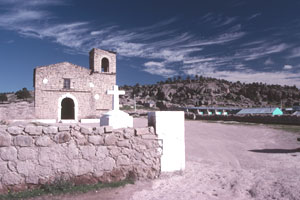
(Creel, Chihuahua, Mexico)
After a short walk we got to the village of St Ignacio. This was little more than a mission church, a school and a few houses. After a few photographs we carried along the road towards the valley. The walk was amazingly peaceful, taking through a series of lush valleys dotted with maize fields and oak woods, The only people we encountered were the Tarahumara going about their ways as they had done for centuries, women washing their clothes in the stream and the men inspecting the fields from horseback.
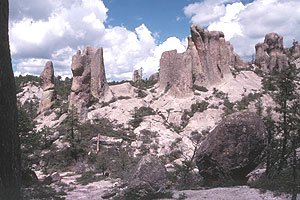
(Creel, Chihuahua, Mexico)
After a couple of hours the path veered off into a small valley of rock pinnacles. However standing next to a makeshift barrier at the entrance of the valley a small boy looked liked trouble. "Cinquo Pesos para Uno" he rather shakily declared. Rather amused we explained to him that we had already paid and showed him our tickets. Other children started to appear from out of the rocks and he repeated his demand. I was all for bargaining but Anna decided in the end to give him a ten peso coin (roughly 80p). He let us through but as if we were in any doubt as to how official the charge was as soon as we were 20m down the hill there was an immense shriek of delight and the six boys started fighting with each other to see how their booty would be split. Letting them get away with it may have caused trouble for subsequent tourists but the small amount of money had meant very little to us and put a smile on their faces.
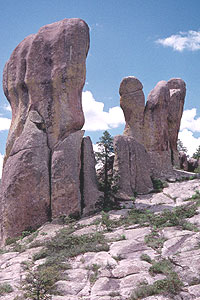
(Creel, Chihuahua, Mexico)
"Valle de los Monjes" was the Spanish name and quite frankly it was difficult to see what resemblance to monks the hundreds of free standing rocks bore. To my mind it was more accurately described by its original Tarahumara name: "Bisabirachi" or "Valley of the Erect Penises". Anyway it is probably best to leave it up to the photographs and let people decide for themselves whether they are monks or penises !
We promptly climbed to the top of one of the less phallic formations and sat for an hour or so to sunbathe and write diaries. After this we had a long walk around the rest of the valley to look out for monk like formations, finding none we headed back to Creel.
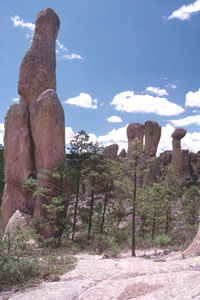
(Creel, Chihuahua, Mexico)
During our stop and on the journey back I managed to get my arms incredibly sunburnt. It seemed like it took forever to get back, and through a combination of the heat and our low level of fitness, by the time we reached the edge of Creel we could hardly walk despite having only gone some 20km. However back at the cabin a shower and a bottle of Sol soon revived us in time for dinner.
Thursday, 22 August 2002
Barrancas del Cobre, Chihuahua, Mexico
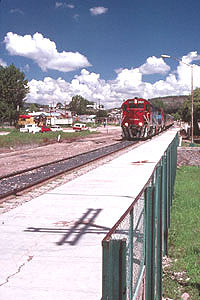
(Barrancas del Cobre, Chihuahua, Mexico)
Our next hop had been pretty much cast in stone since day one. The copper canyon railway or "Ferrocarril Chiuahua al Pacifico" is an amazing feat of engineering - 39 bridges and 86 tunnels - connecting Chihuahua with the coast 660km away. We had skipped the less scenic stretch to Creel but today, which was coincidentally Anna's birthday, we were hopping aboard the 11:30 train down to the coast.
I will skip the morning which was mostly spent hanging around firstly at the hotel then at the railway station as the train did not turn up until twelve. We were waiting on the dusty platform of Creel's train station when we heard the horn of the approaching train and saw its three headlights far away down the track. Although I have never been, and never will be, a train spotter, as the huge locomotive slowly ground to a halt at the station I started to understand what people see in trains. However in retrospect I should be careful to point out that getting your kicks sitting in Crewe junction with an anorak and a thermos noting down the serial numbers of InterCity 125's is really a very, very sick relative of the natural thrill of taking what is claimed to be one of the world's greatest railway journeys.
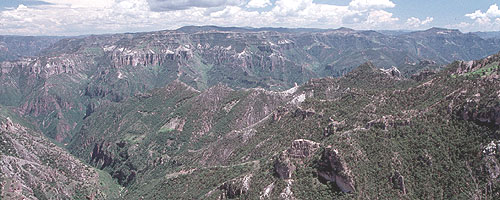
(Barrancas del Cobre, Chihuahua, Mexico)
For a while we were wondering what all the fuss was about. The train slowly progressed through flat countryside very like that around Creel. It was not until the train stopped at Divisadero nearly two hours into the journey that we started to understand. We rushed off the train and then divided down a small lane lined with taco stands and hawkers selling souvenirs and found ourselves on the top of an immense cliff overlooking a fork in the Copper Canyon. The view was amazing but we wondered if we were going to have to keep running out of the train to see what we had come all this way to see.
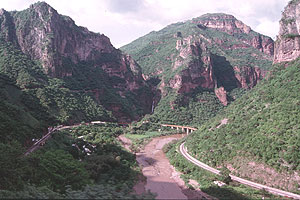
(Barrancas del Cobre, Chihuahua, Mexico)
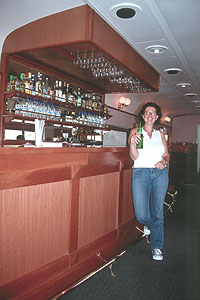
(Barrancas del Cobre, Chihuahua, Mexico)
However after Bahuichivo, some three hours into the journey, the fun really began. The train entered the first of a series of canyons which it was to follow all the way down dropping some 1500m in altitude in the process. The railway line hugged the canyon walls passing through tunnels so often that it was often difficult to take photographs. Several times the railway looped back on itself, going in a massive circle to descend to the floor of a valley that it had entered 100m above its exit point. If you take a close look at the left side of the photograph, vertically half way between the large white building and the bottom of the rock face, you will see the tunnel we enetered the valley from. The shot is taken whilst coming back down the valley to loop around before going down to the valley floor, over the bridge and carry on along the valley on the track which exits from the right of the shot.
The vegetation underwent a slow transformation throughout the journey, From the pine forests of Creel we had descended through the more arid forests we had seen briefly on our bus tour, into a lush humid mountain jungle, reminiscent of the valleys around Macchu Picchu, and finally to cultivated rolling coastal plains. What made the jungle part unique however was the presence of hundreds of organ pipe cacti which managed to push themselves through the tree canopy.
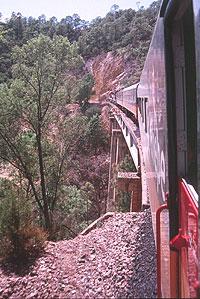
(Barrancas del Cobre, Chihuahua, Mexico)
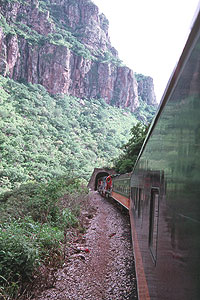
(Barrancas del Cobre, Chihuahua, Mexico)
Anyway it is impossible to describe the scenery in words so it is probably best left to the many photographs I took. Because the train rocked and the scenery was moving past at speed I took more than I normally would as I knew that a lot would be blurred. One thing about the trip is worth noting, we hardly read at all that day. Perhaps eight of the twelve hours was spent staring out of the windows or hanging out of the open windows between carriages to take photographs. And of course we did spend a pleasant half hour in the bar of the train celebrating Anna's birthday.
We finally pulled into Los Mochis station at ten o'clock, some two hours late. Straight away we bundled into a shared taxi to the bus station and got ourselves on the first night bus heading south. We were aiming for Puerto Vallarta and the beach and saw no reason to get stuck in Los Mochis.
Friday, 23 August 2002
Puerto Vallarta, Jalisco, Mexico
The journey was lengthy to say the least. We arrived at a place called Tepic around 11am and then had to change buses. The first bus we found was very definitely "economica" class and took three and a half hours to rattle its way to Puerto Vallarta. Tepic itself was in the mountains so was quite cool and pleasant but as the bus descended through mountain valleys to the jungle covered coastal plain it started to heat up.
When we got off the bus in Puerto Vallarta we immediately understood why it was low season. The humidity was oppressive and the sky overcast. Simply getting on and off the bus with a rucksack resulted in the entire back of my shirt being drenched with sweat. Anna located a room for us, a small apartment with living room and bedroom in a hotel conveniently equipped with a swimming pool.
After settling in we attended to our number one priority, watching the sun set drinking Margaritas by the beach. We found a small beach bar packed with US ex-pats and a two for one happy hour and relaxed. We followed this up with a German Restaurant, by this point we were thoroughly bored by burritos, then went straight to bed to recover from our all night trip.
Saturday, 24 August 2002
Puerto Vallarta, Jalisco, Mexico
We started our first day at the beach by having eggs benedict at one of Puerto Vallarta's (PV) traveller institutions - the Pancake House. When we finally got going it was around eleven. We caught the local bus to Mismaloya, a small beach south of PV that was used by John Huston to film "Night of the Iguana" in the sixties. The film and the romance between its star Richard Burton and Elizabeth Taylor, who came along with him, was responsible for putting PV on the map. Mismayloya's cinema connections do not end there, the jungle behind it was also used to film "Predator" and various burnt out helicopters and other sets still remain.
As exciting as its past was there was not much going on at the beach. However we did manage to get talking to Ricardo, a boat owner who was keen to take us out snorkeling at Los Arcos, a marine park nearby. We negotiated with him an arranged to meet him early the next morning.
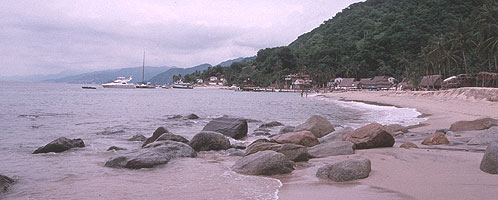
(Puerto Vallarta, Jalisco, Mexico)
We then hopped back on the bus to head for Playa de Las Animas, supposedly PV's best beach and only accessible by boat. We took the bus to the end of the line at Boca de Tomatlan and on walking out on to the beach found that there was a small boat packed with Mexican tourists in the process of leaving. We waded out into the water and jumped on board. Playa de Las Animas was very nice , tropical jungle backing a broad sweep of white sand and coconut palms. I imagine that originally there would have been many such beaches around the bay in which PV is located in before the arrival of high rise blocks of holiday apartments and villas.
The only bad note about the beach was that it played host to an ever changing party of tourists. From what we could work out the majority of people had signed up for boat tours in PV that consisted of four or five set destinations visited in strict rotation. However the flaw in the plan seemed to be that the tourist boats were too large to come in to the short pier so their 200+ occupants would have to be ferried to the beach in groups on twenty on smaller boats. This whole process would take half an hour, the tourists would then go to the beach bar/restaurant or sun themselves for half an hour at which point it would be time for them to queue up gain to be ferried back to the mother ship. The tour companies seemed to have staggered things so there were never more than two boats at the beach at any one time and so to the casual observer it looked like the beach was permanently occupied by queues of Americans arriving and leaving.
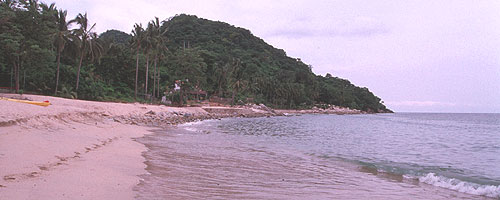
(Puerto Vallarta, Jalisco, Mexico)
Unlike the cattle we had no fixed leaving time so were able to walk up the beach and be pretty much on our own without fear of loosing our place in a queue. We swam for a long time and sunbathed for a while. Even though it was very overcast I still managed to burn my shoulders. As the afternoon wore on however it started to spot with rain and we eventually decided to head back to PV. It Our timing could not have been better, we found a boat going back to Boca and as we got on the bus the heavens opened up. By the time we got back to PV the streets had turned into rivers, with fast flowing water six inches deep. Even in the thirty or so metres backed to the hotel we got completely soaked through.
That night we finally got to celebrate Anna's birthday in style. We went to one of the best restaurants in town which was on the Isla Cuale in the middle of the river Cuale. It was very decadent in a colonial way: candle lit, soft jazz, partially open to the black night air, fans beating away and far too many waiters running around in evening dress. We had a table right next to the river which was too full and fast to harbor mosquitos.
Sunday, 25 August 2002
Puerto Vallarta, Jalisco, Mexico
We had foolishly arranged to meet Ricardo at 8am but during the night Anna's watch stopped so we had no way of judging the time was. In the end we tried to judge it off CNBC and the daylight, which resulted in us being an hour off because we had not realised that it is still dark in PV at eight.
Anyway there was not much we could do about it so we hurried down to Mismaloya where we found Ricardo waiting, board a small motor boat and cruised out to Los Arcos. There we found the visibility to be the main problem. The previous nights rain had swollen the rivers which had in turn flushed a lot of sediment out into the bay. On top of this and despite being late, we were still too early and a lot of the good snorkeling spots were still in shadow. Nevertheless by diving down to around 5m I was able to see quite a lot, including a Honey Combed Moray Eel out on its morning prowl. Just as we got ready to leave the tour groups arrived no doubt scaring off the majority of what we had just seen.
The rest of the day was a lot less adventurous thanks to my burnt shoulders. We hung around the hotel swimming pool, had a very long lunch then in the evening walked up to the north part of PV which had little more to offer in the way of sites than the south part with the exception of an oldish church. We followed this up with another Margarita/Sunset session and this time talked to some of the ex-pats, the ones we found fortunately being from London.
Monday, 26 August 2002
Guadalajara, Jalisco, Mexico
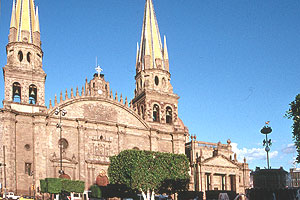
(Guadalajara, Jalisco, Mexico)
After a quick early morning swim we were back on the road again, this time making our way slowly back to Mexico. First stop was Guadalajara surprisingly five or six hours away. This time rather than using the painfully slow bus we had taken to PV we managed to find an ultra luxury bus which took a toll road that was so completely empty of cars it seemed like our bus was the only vehicle using it.
Guadalajara's bus terminal was curiously some 15km out of town so we had to wait for a bus into the centre. By the time we had done this and checked into our hotel, which was an old coaching inn, it was almost four which allowed us little time to look around. As well as a quick glance around the cathedral we also went to a place called "Mariachi Plaza" on the look out for Sombrero topped bands of musicians which Guadalajara is famous for. Although there were a few specimens there they also seemed to be having coffee and looked unlikely to spring into action.
Because of the lack of luck in Mariachi Plaza, after a quick dinner of enchiladas with mole poblano a sauce combining chocolate and chilies, we headed down to "La Feria" for a second attempt. This turned out to be a bar restaurant decorated in gaudy festival colours with all sorts of paper brightly coloured constructions, donkies, guitars etc. hanging from the ceiling. The show started off well with a band of violins and trumpets playing from the staircase, followed by a pair of spectacular dancers. Sadly it went down hill from there with a male singer who admittedly had the largest sombrero I have ever witnessed but who unfortunately reminded me of a bad caraoke act. Although we had a good time we decided to call it a night after the final act, a comedian whose jokes seemed to revolve either around him pretending to be drunk and fall off the stage or sticking his finger up his bottom.
Tuesday, 27 August 2002
Tequila, Jalisco, Mexico
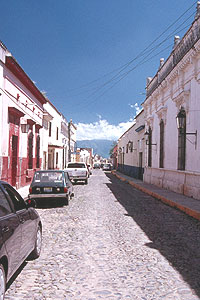
(Tequila, Jalisco, Mexico)
The day's itinerary was to go to Tequila a small town 50km west of Guadalajara and the centre for the Tequila making industry. Unfortunately things were not going to be made easy for us with the bus leaving from the "old" bus station close to the centre of town. This meant that rather than being able to leave our rucksacks in the bus station in preparation for the onward journey we would have to leave them at the hotel and pick them up on a dash from one station to another.
When we got to the "Old" bus station we found that it was not a misnomer, everything in the place was decaying and customs from a previous age, such as paying an entrance fee, seemed to still be in effect. The bus we found was very battered and our bus driver was keen on setting a record slowest time for the 50km journey. It took two hours and by the time we dribbled into town it was 11:30. we dashed to the Sauza distillery only to find we had missed the morning tour and that the next one was not until 14:25.
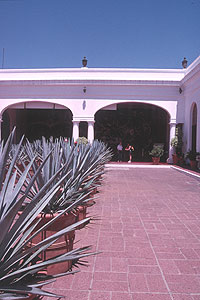
(Tequila, Jalisco, Mexico)
We could not give up having got this far so set around spending the next couple of hours in Tequila in the most constructive way we could. This turned out to be easier said than done as there was nothing more to it than a waffle grid of dusty streets and a Zocalo (central square) full of equally bored looking locals who presumably were trying to pass more than just a couple of hours. We went to the museum of Tequila for half an hour then went to the only restaurant in town, a fish restaurant. Here we decided that being in an arid climate high up in the mountains, hours away from the coast, it was probably best to opt for pizza.
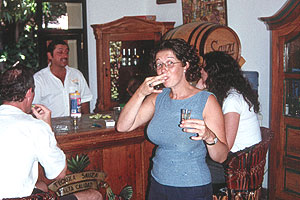
(Tequila, Jalisco, Mexico)
Things did not get better, when the tour of the distillery finally set off twenty minutes late we were told straight away that there was no harvesting or processing of the agave cactus as it was the rainy season. Despite this it was fairly fascinating and our guide was very good. Tequila is made from the blue agave cactus which is only cultivated in very confined areas in Mexico the result of which is that the fields around Tequila all have this amazing blue grey tint. The cacti are grown for seven years before being harvested by a Jimador who cuts off all the leave to reveal a 50cm diameter ball shaped heart known as a pina. These hearts are then chopped up, cooked in ovens for eight hours and then pulped to extract the juice. This juice then has sugar and yeast added to, fermented and then left to rest either for a few months or for a few years in the case of "Anejo" or aged Tequila.
The tour of the plant was very comprehensive, they even showed us their bottling plant. But it was the next bit, the tasting that was what we had been waiting for, they took us to a small bar in the hacienda of the Sauza family and gave us multiple shots of Tequila interspersed with Tequila based cocktails.
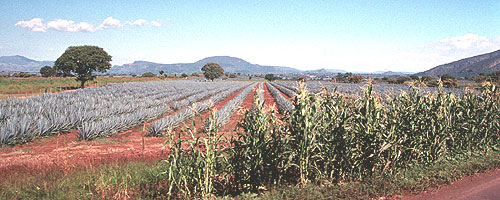
(Tequila, Jalisco, Mexico)
We had a difficult job dragging ourselves away at 16:30 to find a bus. This time the journey was slightly quicker at an hour and three quarters but this still meant that on reaching Guadalajara we had to grab a taxi to run between the bus stations via our hotel. When we got to the bus station we found that there were no more buses to Patzcuaro, originally our next destination, and that we would have to settle for going to Morellia.
The bus itself was amazing, it was like being in first class on an airplane with massive seats and only three per row. There were even headphones to watch the in flight movie, the instantly forgettable "Naked Gun 33 1/3". It was a sharp contrast to some of the buses we had taken before, it seemed that the closer you got to the capital, the greater competition resulted in a huge difference in classes of coach transport.
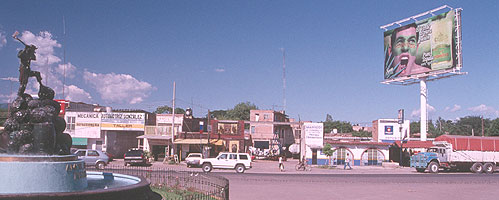
(Tequila, Jalisco, Mexico)
When we got to Morelia bus station we got yet another surprise, it was completely brand new and seemed to be modelled on an airport with actual departure and arrival gates etc. Anyway our surprise was counteracted by the fact that yet again we seemed to be tens of kilometers out of the city centre and it was now midnight. We found a hotel that was still open and got shoved into the last available room, which was probably the worst we had stayed in during our trip. The room was at some sort of dubious mezzanine level between ground and first floor, was impossible to walk around in without stooping and had a window which stretched from floor to crotch level. Anyone who has seen the film "Being John Malkovich" should have a fair idea of what I am talking about.
Wednesday, 28 August 2002
Morelia, Michoacan de Ocampo, Mexico
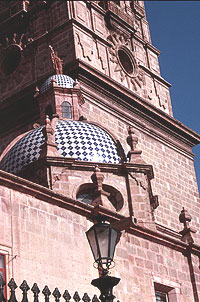
(Morelia, Michoacan de Ocampo, Mexico)
We woke up not knowing quite what to do. We were behind on the schedule that we had decided upon back in Puerto Vallarta as we were meant to be in Patzcuaro that morning and be getting a bus to Mexico that evening. We considered attempting to go to Patzcuaro and back in a day as we had done with Tequila and Guadalajara but seeing as how unsuccessful that had been it did not seem like such a good idea. Patzcuaro seemed to be the sort of place that warranted more than a few hours but if we stayed the night there we would not see everything we wanted to see in Mexico. In the end we were tired of endless bus journeys and so decided to give Patzcuaro a miss this time round, spend the morning looking around Morelia and go to Mexico in the afternoon.
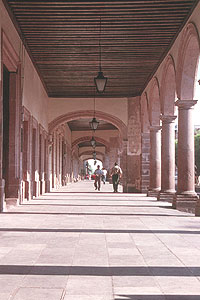
(Morelia, Michoacan de Ocampo, Mexico)
This turned out to be a fortunate decision because Morelia it turned out has some of the most beautiful colonial spanish architecture in Mexico. Its city centre is laid out around several squares which are surrounded by cool arcades and small parks. We had breakfast in a beautiful first floor cafe overlooking the central square an cathedral. Following this we walked a short distance to see the city's aqueduct and then went to an artesanias market housed in a converted convent.
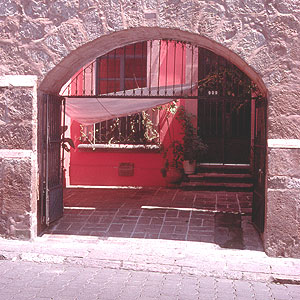
(Morelia, Michoacan de Ocampo, Mexico)
Our bus journey to Mexico that afternoon was again the height of luxury. It was quite a long journey, six or seven hours, lengthened by the fact that the bus driver appeared to take an immense detour to enter the city by the North. When we got off the bus the cold chill of the air reminded us of Mexico's 2100m elevation. We had not been able to get a room in the hotel we had stayed previously so this time had decided to stay in the historical centre of town just behind the Cathedral. We checked in then went for dinner at an "Alto Cocina" (Haute Cuisine) restaurant called La Casa de Sirens and had the restuarant pretty much to ourselves.
Thursday, 29 August 2002
Teotihuacan, Mexico, Mexico
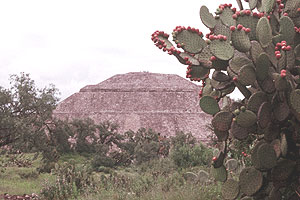
(Teotihuacan, Mexico, Mexico)
Our number one priority in Mexico was to go to the ruins of Teotihuacan, an ancient city founded by forerunners of the Aztecs who built up what was the largest pre-Hispanic empire before abandoning the city in the 7th century. Although the city of the Aztecs, Tenochtitlan, may be more well known with its tales of Cortes' defeat of Montezuma it unfortunately was razed by the Spaniards and Mexico built on its ruins. Thus to get any idea of the scale of Aztec cities Teotihuacan is the next best thing.
We took a bus from Mexico's northern bus terminal which meant for the first time we could use the underground system. It was quite an experience, Mexico has many different lines and as well as giving each line a colour they have designed symbols for each tube station. For example Chapultec, the central park, is represented by a picture of a grasshopper (the name means "Hill of the Grasshopper") and "La Merced" represented by a picture of a market stall. Each station would be handily labelled with its icon and signs for platforms also labelled with the terminus of that line. It was also incredibly clean and cheap, only 15p to travel practically anywhere within a city of 20 million people.
The only apparent problem with the metro is that bag snatching are pick-pocketing is endemic. It is one of the few countries I have been to where even the locals, as opposed to paranoid tourists, wear their rucksacks the wrong way around so they can keep an eye on their possessions. We took these warning signs to heart and generally avoided crowded cars and anybody that looked remotely dodgy to us. The tactic seemed to pay off as we avoided any trouble,
We got to the bus station and found a rather dilapidated bus heading to "Pyramides" and jumped in. It took about an hour and as we approached we got our first glimpse of the Pyramid of the Sun, one of Tetihuacan's chief structures and apparently the third largest pyramid in the world. The first being the Great Pyramid of Giza and the third being Cholula, another pyramid in Mexico which through erosion is completely indistinguishable from a large hill.
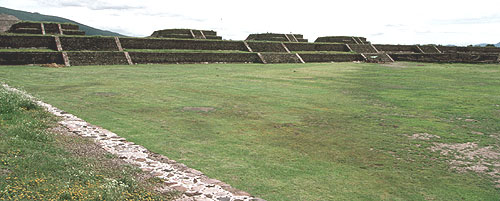
(Teotihuacan, Mexico, Mexico)
On entering the site the first structure we came to was "La Ciudadela" which apparently was an administrative building at the centre of the city. It is basically a large square enclosed by wide walls on which small stepped pyramids had been built at regular intervals. Within the square the foundations of a few structures survive including some very symmetrical living quarters.
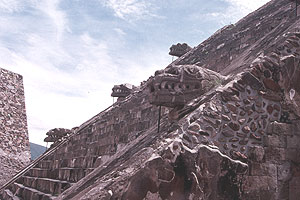
(Teotihuacan, Mexico, Mexico)
The main structure however is the Temple of Quetzlcoatl (the plumed serpent). At this point it is worth explaining briefly about the calendar system of the pre-hispanic cultures. They had two calendar cycles, one based on a 260 days, which represented the spiritual world, and the other on a 365 days, representing the solar year or material world. Each cycle was based on groups of twenty days with the 365 day cycle having five left over days which were considered "unlucky". The upshot of this was that the cycles only began on the same solar day every 52 years and the start of the 52 year cycle represented to them the conquering of the material world by the spiritual world and the start of a new age. To mark this new age temples would be rebuilt, the new temple being built on top of the old. By digging into temples of this era archaeologists uncover layers of temples neatly stacked inside each other like Russian dolls.
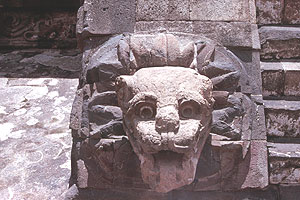
(Teotihuacan, Mexico, Mexico)
In the case of the Temple of Quetzlcoatl this was fortunate as the newer temple was badly eroded and mainly featureless but the older temple when uncovered by the archaeologists was found to be a stepped pyramid decorated with carved jaguar and serpent heads. The richness of the carving, along with a few surviving fragments of its paint, really conjure up the richness of the city. This is lucky because the majority of the remaining structures are very plain, seemingly made from rough, black pumice blocks re pointed with modern cement. I imagined that at one point the structures would have been covered in plaster and brightly painted. As it is it looks rather gloomy and, with its limited restoration, slightly artificial.
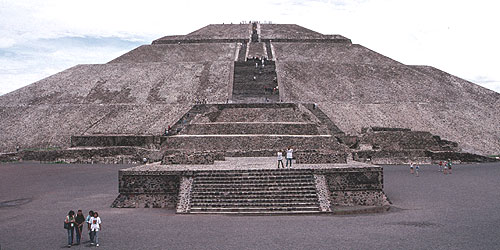
(Teotihuacan, Mexico, Mexico)
We then started walking along the so called "Avenue of the Dead" the 2km long north-south boulevard that originally ran the entire length of the city. After quite a while of going up and down between the sunken plazas of which the lower part of the avenue is composed we came to the base of the Pyramid of the Sun. During its reconstruction at the turn of the century the 70m high stepped pyramid sadly gained an extra tier. It quite clearly should have only had four tiers but the top tier seems to have been restored as two half height tiers. This did not make it any easier to climb. Unlike a lot of the people around us we had already acclimatised to the 2300m altitude however this was completely negated by our sadly lacking fitness levels. When we finally reached the top the view was impressive, not only of the site itself whose structures are all eerily symmetrical, but of the ring of mountains which surrounds the site.
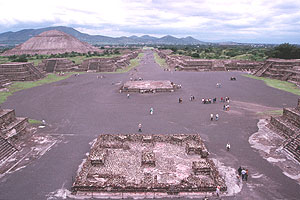
(Teotihuacan, Mexico, Mexico)
Carrying on to the end of the Avenue of the Dead the final stop was the slightly lower Pyramid of the Moon. By this point, having walked 2km and climbed up and down the Pyramid of the Sun and having visited a lot of the intervening structures, we began to suspect that the reason the Avenue of the Dead was so named was because that's exactly how you felt when you got to the end of it. Thankfully the top half of the Pyramid was undergoing renovation but even from halfway up the view was startling. Again the symmetrical layout of the buildings was very evident but also how each of these buildings had been laid out exactly perpendicular to the avenue. It also became clear that the many grassy mounds to either side of the excavated buildings were yet to be uncovered pyramids and administrative buildings.
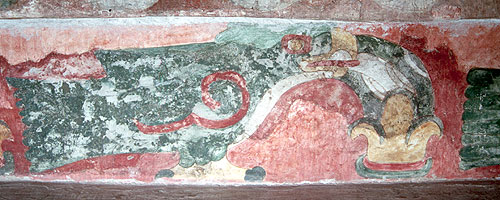
(Teotihuacan, Mexico, Mexico)
Our climbing over we then visited a small temple complex, different incarnations of which had been excavated to reveal rich painted wall murals. We followed this up with a trip to the site museum which was well laid out with explanations in English as well as Spanish.
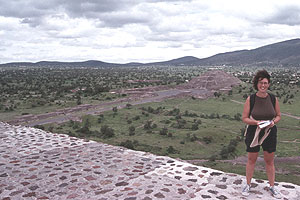
(Teotihuacan, Mexico, Mexico)
Back in town we again went to dinner at an "Alto Cocina" Mexican restaurant in an attempt to discover another side to Mexican cooking apart from enchiladas and tacos. This time we were not on our own, at least two of the other tables were occupied. I was served a pepper stuffed with meat and fruits and covered in a sweet nougat sauce which was not what I ordered in the slightest. We came away none the wiser and wishing that we had gone to the next door Taco Inn.
Friday, 30 August 2002
Mexico, Mexico
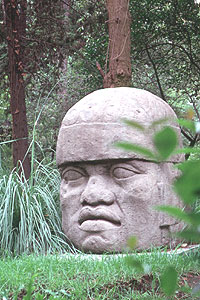
(Mexico, Mexico)
We started the day off with a quick walk around the centre of Mexico and a visit to a small museum dedicated to the murals of Diego Rivera. Rivera was one of Mexico's greatest artists and in the first half of the twentieth century worked for the Ministry of Education raising the consciousness of the newly liberated Mexican state through the painting of huge public murals. The museum houses his mural "Dream of a Sunday Afternoon in the Alameda" which depicts practically everyone who was anyone in Mexican history, from Cortes to Diego himself, hanging out together in the city's leafy central park. I was not quite sure what to make of it, the two dimensional nature of it and the way perspective and reality have gone out the door to allow everyone to fit in the picture made it look deceptively childlike and because of this whatever message it was trying to portray was unclear. The labelling in the museum did not really help as there were only a few fragments in English.
After this we hopped back on the underground to have lunch in an area of town called Condesa followed by a visit the Museo Nacional de Antropologia, the National Museum of Anthropology. This ranked as our number two priority in Mexico as it is rightfully considered one of the top museums in the world, not only for the size of its collection but also in terms of the thorough way it is presented. The Museum sits in Chapultepec park which we first had a quick stroll through. It consists of a series of ten large halls, each of which is dedicated to one of the various pre-Hispanic cultures, arranged around an central open air quadrangle. Each of the halls is stuffed with a range of artifacts, models and reconstructions arranged carefully to build up a picture of life in that culture. The explanations were in both English and Spanish and went into almost too much detail. If taken at a reasonable pace it would probably take an hour to cover just a single hall. In some ways it was fortunate that the Maya and Olmec halls were being refurbished as in five hours we had barely enough time to cover Teotihuacan, the Toltecs and the Aztecs. We decided that when we eventually go back to visit the south of Mexico we would have to return to the museum to pick up where we left off.
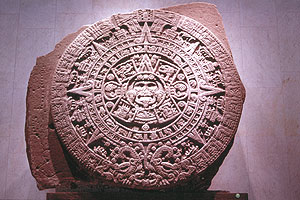
(Mexico, Mexico)
It is difficult to single out any particular pieces but one of the most interesting item was the 24 ton Piedra del Sol. It is a depiction of the Aztec cosmos and was carved by the Aztecs a few years before the arrival of the Spanish who when they saw it promptly buried it because they feared it would cause unrest. It was not rediscovered until 1790. In the centre is the sun god with two claws holding sacrificed human hearts either side. Around this are the symbols for the previous four incarnations of the sun: a jaguar, wind, water and fiery rain. Surrounding this are symbols representing the twenty days of the Aztec month and finally two serpents frame the entire disc. I also managed to get photographs of the Ocelocuauhxicalli, a statue of a jaguar with a square hollow carved in its back to accept sacrificed human hearts. Finally, by leaning over the fence of a neighboring section I managed to get a picture of an Olmec stone head. The head is one of many found at La Venta, a site in the jungles of Tabasco province to the South on the Gulf of Mexico, which have caused a great deal of speculation with their apparently Negroid features.
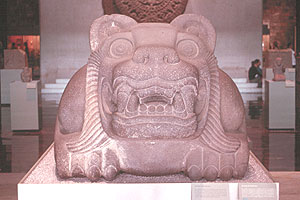
(Mexico, Mexico)
That night there was some sort of demonstration on in central Mexico so we abandoned our search for haute cuisine and headed straight for the safety of the Zona Rosa. I ended up having a very un-Mexican veal sausage and some very cold beer. Sadly the sausage was a bit suspect and I spent most of the night regretting it !!
Saturday, 31 August 2002
Coyoacan, Mexico, Mexico
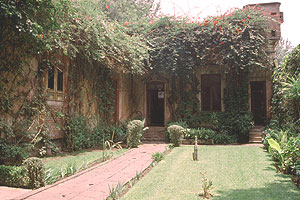
(Coyoacan, Mexico, Mexico)
Having not slept most of the night our final day in Mexico got off to a slow start. We ate breakfast at our hotel and then popped around to the Cathedral which was just the other side of our block on the Zocalo. Whilst Anna was inside I got chatting to a thoroughly strange chap who claimed to be from the Mexican tourist board and wanted to try and persuade me to go to see the canals at Xochimilco with him for fifty dollars. I did not know quite what to make of him, he didn't seem like the genuine article but since we were not going to pay anyone fifty dollars to take us somewhere that was on the underground line it hardly mattered.
We then set off for Coyoacan, originally a small town outside Mexico which then got subsumed by the growing metropolis and which in the 1930's played host to a very interesting set of people. It was in Coyoacan that the artist Frida Kahlo was born and lived with her husband Diego Rivera. It was also where Leon Trotsky, having been exiled from Russia came to live, have an affair with Frida Kahlo and meet his untimely end in the form of an ice axe.
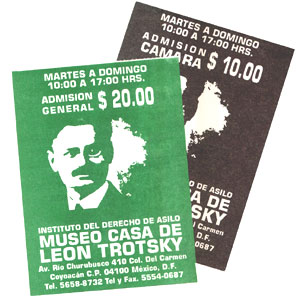
(Coyoacan, Mexico, Mexico)
The underground stopped quite a way from the centre of town so we took a walk through the city's nursery which bizarrely seemed also to play host to an amazing amount of joggers presumably exercising under the assumption that the growing plants would somehow protect them from the toxic air of the city. We then cut through some back streets passing some original 16th century colonial villas and finally finding a coffee shop where we were able to buy some Mexican Coffee beans to take back to England.
To quickly explain, Frida Kahlo was a painter who was crippled by the combination of polio and a bus accident and so embarked upon the mission of conveying her pain through her work. She was a Marxist and together with her husband Diego Rivera built up a left-wing circle of friends within which she had various bisexual affairs. Her family house, the "Blue House", has been turned into a museum and its here that we headed next. Sadly the house was nowhere as interesting as her life, and unfortunately the majority of her paintings are housed in various other museums so there was very little to look at apart from her possessions. I left none the wiser and a little annoyed as photography was prohibited and taking a few atmospheric photographs was about the only reason I could see for visiting the house.
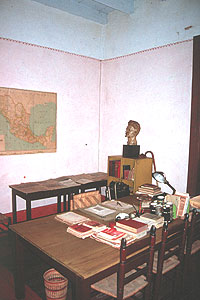
(Coyoacan, Mexico, Mexico)
However we were not disappointed by our next destination, Trotsky's house. Trotsky was expelled from Russia in 1929 and finally found refuge in Mexico in 1937 with the help of Diego Rivera and Frida Kahlo. He and his wife originally lived with the artists until an affair between Leon and Frida caused a falling out and they moved to their own house. The house has been pretty much left in exactly the way it was in 1940 when an agent of Stalin finally caught up with Trotsky and killed him at his desk with an ice axe. It was incredibly atmospheric: the paint was peeling off the walls; all of Trotsky's possessions such as his library have been left in place and there were not too many tourists so we pretty much had the small dark house to ourselves.
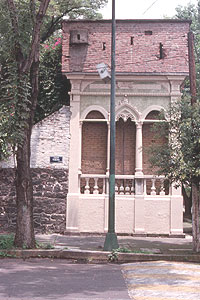
(Coyoacan, Mexico, Mexico)
Trotsky had also been the victim of an unsuccessful first attempt on his life by a band, led strangely by the painter David Siqueiros, who sprayed the house with bullets yet managed to miss the Trotsky's. In response to this attack the Trotsky's were forced to brick up windows, add watchtowers to their house and employ an armed guard. Even today you can clearly see the bullet holes in the bedroom walls which again added to the atmosphere. On top of all this you were also allowed to bring your camera in for a price so it was a lot better value than Frida's house!
In comparison to Trotsky's house the rest of our final afternoon was fairly mundane. We took the underground back towards the centre of town and stopped off at a rather large artesania market where we hunted round for things worth bringing back to England. We settled on a rather gruesome looking devil mask of the sort used for "Day of the Dead" celebrations. We then returned to the hotel, got a taxi to drive us out through the congested streets of Mexico to the airport and then hopped on the plane that, after ten hours and yet another sleepless night, finally took us back home.





